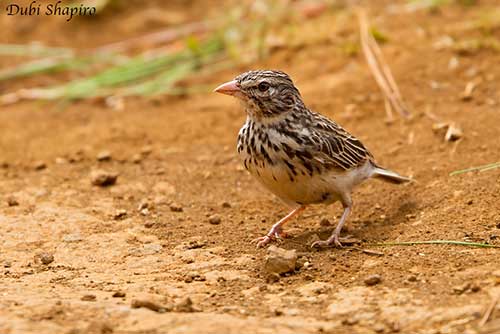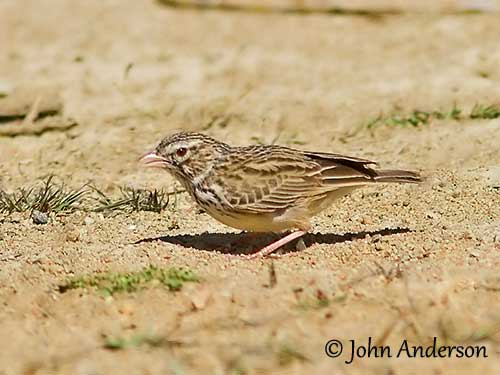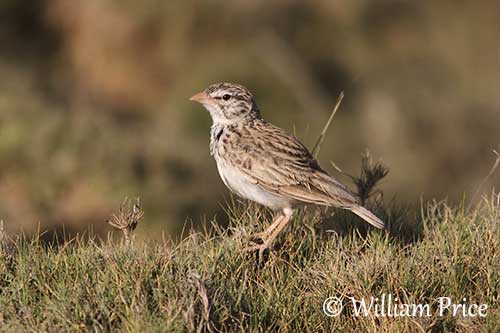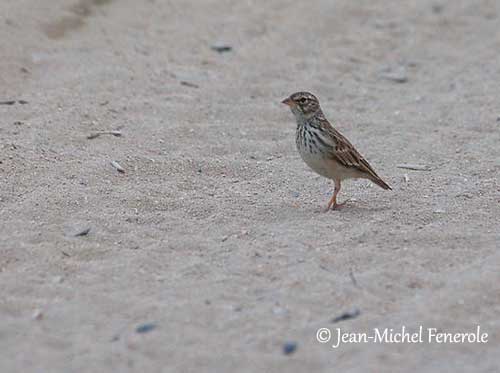
PROTECTION / THREATS / STATUS:
The Madagascan Lark is common and widespread throughout the island in a variety of open habitats. The species has probably benefited from the deforestation, showing adaptation to cultivated areas created by forest clearance, involving increasing population.
The Madagascan Lark is not globally threatened and is currently evaluated as Least Concern.
Fr: Alouette malgache
Ang: Madagascan Lark
All: Hovalerche
Esp: Alondra Malgache
Ita: Allodola del Madagascar
Nd: Hovaleeuwerik
Sd: madagaskarfinklärka
Mal: Boria, Borisa, Jorioke, Soritsy, Sorohitra
Photographers:
John Anderson
John Anderson Photo Galleries
Jean Michel Fenerole
Photos d’Oiseaux du monde
William Price
PBase-tereksandpiper & Flickr William Price
Dubi Shapiro
Dubi Shapiro Photo Galleries & Dubi Shapiro's Pictures on IBC
Text by Nicole Bouglouan
Sources :
HANDBOOK OF THE BIRDS OF THE WORLD Vol 9 - by Josep del Hoyo - Andrew Elliot - David Christie - Lynx Edicions - ISBN: 8487334695
Wildlife of Madagascar par Ken Behrens,Keith Barnes - ISBN: 140088067X, 9781400880676 – Editeur: Princeton University Press, 2016
Birds of Madagascar and the Indian Ocean Islands Par Roger Safford, Adrian Skerrett, Frank Hawkins – ISBN: 1472924118, 9781472924117- Editeur: Bloomsbury Publishing, 2015
The Birds of Africa: Volume VIII: The Malagasy Region: Madagascar, Seychelles, Comoros, Mascarenes - Par Roger Safford, Frank Hawkins – ISBN: 1408190494, 9781408190494- Editeur: A&C Black, 2013
Birds of Madagascar: A Photographic Guide Par Pete Morris, Frank Hawkins – ISBN: 0300077556, 9780300077551- Editeur: Yale University Press, 1998
Madagascan Lark
Eremopterix hova
Passeriformes Order – Alaudidae Family
INTRODUCTION:
The Madagascan Lark is endemic to Madagascar where it frequents a variety of open habitats from sea-level to high elevations. It feeds on seeds and insects usually caught on the ground. The species is monogamous and the male performs aerial displays typical of Alaudidae.
This species was formerly included in the genus Mirafra, but it is now in the sparrow-lark genus Eremopterix, following genetic studies.
The Madagascan Lark is one of the most widespread species on the island. The population is increasing following forest clearance creating new suitable habitats.
DESCRIPTION OF THE BIRD:
Biometrics:
Length: 13 cm
The Madagascan Lark has pale brown plumage with dark brown streaks above. In fresh plumage, the feathers are fringed with buff. The flight-feathers are brown and narrowly fringed pale buff. The tail is dark brown with buffy white outer rectrices.
The underparts are whitish but the breast is heavily streaked dark brown. Flanks and undertail-coverts are tinged darker buff.

On the head, the streaked crown contrasts with the broad, pale buff supercilium. We can see a narrow, dark eye stripe and a pale buff crescent below the eye. There is a dark moustachial stripe bordering the dark, spotted and streaked pale buff cheeks. Ear-coverts and hind cheeks are darker. Chin and throat are buffy-white with fine dark brown spotting. The pale buff neck sides form a pale collar.
The conical bill is pinkish to grey-horn. The eyes are dark brown. Legs and feet are pale pinkish-flesh.
Male and female are similar.
The juvenile has warmer brown plumage above with scaly pattern on crown, mantle, scapulars and back. The breast is spotted rather than streaked.
RANGE:
The Madagascan Lark is distributed in all parts of the island, especially in open habitats.
HABITAT:
The Madagascan Lark occurs in a wide variety of open habitats but it is absent from densely wooded areas and forest. It frequents grassland, dry shrubland and open woodland, and can be regularly seen on roads. It is present from sea-level up to 2,500 metres of elevation at least.
The predilection of numerous Alaudidae for arid environments is well known.
CALLS AND SONGS: SOUNDS BY XENO-CANTO
The Madagascan Lark gives some “chirrup” and short “chit”.
The song is loud and melodious, although being short and monotonous. It is usually given in flight. It is a high-pitched “chiriip-chit-it-per-chrrip” and there are many variants such as “chriiit…pitit…chirreep”. It lasts 3-5 seconds and is repeated during several minutes. We can also hear a “chirrii-ee” repeated several times at 1,5/2 seconds intervals.

BEHAVIOUR IN THE WILD:
The Madagascan Lark feeds on seeds and small insects including grasshoppers, beetles, ants and flies. The grass seeds are an important part of the diet, and it probably takes rice too. It may ingest some pebbles or sand.
The Madagascan Lark is usually found in pairs or in small groups foraging on the ground. It searches for seeds and insects by running quickly or by making short flights. The prey is picked up from the ground and the larger ones are beaten to pieces before to be swallowed.
The male sings in flight and performs aerial displays to advertise the territory. It circles in the air or flies into the wind, often up to 100/150 metres above the ground with rapid wingbeats interspersed with glides and while singing. At the end of the song, the bird drops quickly and silently with half-closed wings.
The Madagascan Lark is monogamous and territorial. It nests on the ground.
The species is probably mostly resident.
Like numerous Alaudidae, it performs aerial displays similar to Woodlark and during which it circles or flies into the wind before to drop back to earth.

REPRODUCTION OF THIS SPECIES:
The breeding season occurs throughout the year, with no clear peaks.
The Madagascan Lark builds an open bowl in hollow in sand or soil, often at base of a grass tuft or against a piece of wood. The area around the nest is usually covered by grass or bark or other natural objects, in order to hide the nest-site. The cup-shaped structure is lined with fine grass or plant fibres. It is placed in dry area with grass covert, or sometimes on hummocks in the dry parts of grassland partly flooded by high tides.
The female lays two whitish eggs with small, pale brown spots and dots. Information on incubation and fledging periods is currently lacking.
However, the incubation is short among Alaudidae species and lasts11-13 days. Both parents care for the chicks that leave the nest 12-14 days after hatching or sooner if they are disturbed. They depend on adults during almost a month before to become independent.
If the nest is threatened, an adult flies away or feigns injury in order to lead the predator away from the nest-site.
